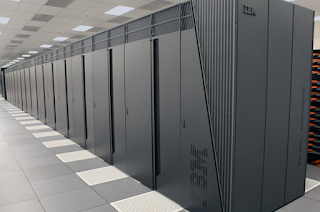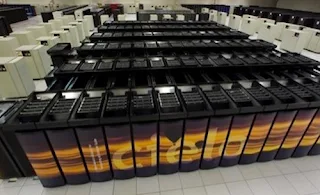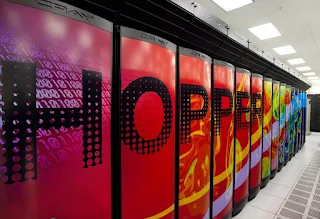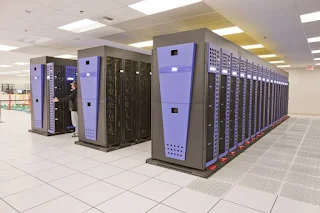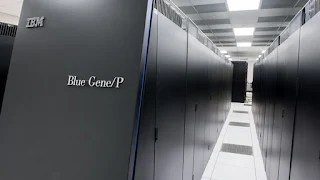What is a supercomputer?
A supercomputer is a powerful computer consisting of many processors that work in parallel to perform a complex task. Supercomputers are changing the way scientists study the origins of our universe, design new drugs for public health, and forecast global weather patterns. The Energy Department's National Labs have some of the most significant high-performance computing resources available, including 32 of the 500 fastest supercomputers in the world.
Supercomputer Glossary
Computer Cluster:
A computing cluster is a set of connected computers or processors that work together in such a way that they can be viewed as a single system.
Operating Systems:
An operating system is a software platform that manages the computer's memory, processes, and all of its software and hardware.
LINPACK Benchmark
The LINPACK Benchmark is a yardstick of performance for high-performance computing systems that requires the computer to solve a dense system of linear equations.
Speed
Flops, a unit of measurement for computer performance defined as float point operations, essentially calculations, per second
- Teraflop: one trillion floating point operations per second.
- Petaflop: one quadrillion floating-point operations per second.
- Exaflop: one quintillion floating-point operations per second.
Storage
Bytes, a unit of measurement for electronic data consisting of 8 bits.
- Terabyte: one trillion bytes
- Petabyte: one quadrillion bytes
- Exabyte: one quintillion bytes
Processing
Parallel Processing: Breaking a large task into many smaller ones to be performed simultaneously across multiple processors.
Central Processing Unit: The CPU is a traditional processor with the circuitry necessary to perform and execute instructions from programs on the computer
Graphics Processing Unit: The GPU is a processor normally used to power the display of images and motion on computer monitors. However, GPUs are equally suited to performing high computations, such as those conducted on supercomputers, at higher speeds than the traditional CPU, or central processing unit.
Core: A core is the independent hardware unit responsible for processing as part of a CPU or GPU. Each CPU or GPU in a supercomputer contains multiple cores.
Supercomputer: Modeling & Simulation
Supercomputers are especially good for the modeling and simulation of complex, dynamic systems with many data points that would be too expensive, impractical, or impossible to physically demonstrate. Data scientists write codes and algorithms that simulate each individual component of the model or process being explored.
- Evolution of Our Universe
Scientists can use a supercomputer to simulate the formulation of our universe, from the big bang to today. the computer simulates the interaction of small bits of matter, represented by particles, with the various have of physics over time. As the simulation progresses, the small pieces of matter are pulled together by gravity into galaxy clusters and superclusters.
- Climate Change
Supercomputers can be used to model the complex physical, biological and chemical processes that impact the Earth's climate over time. As supercomputers become even faster, scientists believe that they will be able to simulate the Earth's climate in even greater detail, perhaps down to the level of a single square kilometer.
- Biological Systems
Supercomputers can be used to create virtual simulations of complex biological systems, such as organs. Such models can demonstrate processes like electrical flow in the heart r activity in the brain at the cellular level.
- Weather Forecasting
Weather scientists use supercomputers to run models that predict global or regional weather conditions, ocean conditions, severe weather potential, and hurricane development.
- Renewable Energy
Supercomputers can be used to simulate the operating conditions that impact renewable energy technologies, study new materials and transmission grid integration, and perform life cycle analyses.
Anatomy of a Supercomputer
- Chip
A chip is a small electronic circuit fabricated on a piece of semiconducting material that serves as a microprocessor for the computer.
- Compute Card
A compute card contains a chip and dynamic memory, which are known collectively as a node.
- Node Board
The node board contains a collection of computer cards, which are connected by fiber optic cables and cooled by water or air.
- Fiber-optic cables are necessary for the high data transfer rate needed when linking the various parts of supercomputers together. Prior to decommissioning Los Alamos National Lab's Roadrunner was linked together by 92 km of fiber optic cable.
- Water Lines pump water into the supercomputer to cool the sensitive electronics, boosting energy efficiency and maintaining reliability.
- Midplane:
Each Midplane holds a group of node boards and includes a service card used for control, monitoring, and diagnostic functions.
- Rack:
A rack is a cabinet or case that contains a section of the supercomputer's hardware. Each rack contains two midplanes and most supercomputers are comprised of multiple racks.
Top 8 Supercomputers at National Labs
1. Titan
Titan or OLCF-3 was a supercomputer built by Cray at Oak Ridge National Laboratory for use in a variety of science projects. Titan was an upgrade of Jaguar, a previous supercomputer at Oak Ridge, that uses graphics processing units (GPUs) in addition to conventional central processing units (CPUs). Titan was the first such hybrid to perform over 10 petaFLOPS. The upgrade began in October 2011, commenced stability testing in October 2012 and it became available to researchers in early 2013. The initial cost of the upgrade was US$60 million, funded primarily by the United States Department of Energy.
Location: Oak Ridge National Laboratory
Speed: 17.59 PFlops/s
Power: 8,209.00 kW
Year: 2012
2. Sequoia
IBM Sequoia was a petascale Blue Gene/Q supercomputer constructed by IBM for the National Nuclear Security Administration as part of the Advanced Simulation and Computing Program (ASC). It was delivered to the Lawrence Livermore National Laboratory (LLNL) in 2011 and was fully deployed in June 2012. Sequoia was dismantled in 2020, its last position on the top500.org list was #22 in the November 2019 list.
Location: Lawrence Livermore National Laboratory
Speed: 17.17 PFlop/s
Power: 7,890.00 kW
Year: 2011
3. Mira
Mira is a retired petascale Blue Gene/Q supercomputer. As of November 2017, it is listed on TOP500 as the 11th fastest supercomputer in the world, while it debuted June 2012 in 3rd place. It has a performance of 8.59 petaflops (LINPACK) and consumes 3.9 MW. The supercomputer was constructed by IBM for Argonne National Laboratory's Argonne Leadership Computing Facility with the support of the United States Department of Energy, and partially funded by the National Science Foundation. Mira was used for scientific research, including studies in the fields of material science, climatology, seismology, and computational chemistry. The supercomputer was used initially for sixteen projects selected by the Department of Energy.
Location: Argonne National Laboratory
Speed: 8.59 PFlop/s
Power: 3,945.00 kW
Year: 2012
4. Vulcan
Vulcan was one of the largest, most capable computational resources available in the U.S. for industrial collaborators while it was commissioned from 2012–2019. This prodigious unclassified supercomputer was shared by the M&IC and ASC programs, with 1.5 of its 5 petaflops directly supporting NNSA’s mission to enhance U.S. economic competitiveness. Partners accessed Vulcan, whether for open, publishable science or business-sensitive and proprietary research, through the High-Performance Computing Innovation Center.
Location: Lawrence Livermore National Laboratory
Speed: 4.29 PFlop/s
Power: 1,972.00 kW
Year: 2012
5. Cielo
Cielo was a United States supercomputer located at Los Alamos National Laboratory. Built by Cray Inc, the computer was part of the Advanced Simulation and Computing Program to maintain the United States nuclear stockpile.
Location: Los Alamos National Laboratory
Speed: 1.11 PFlop/s
Power: 3,890.00 kW
Year: 2011
6. Hopper
The National Energy Research Scientific Computing Center's Hopper supercomputer was retired on Dec. 15. It was one of the first to use petaflop technology, and the first NERSC had on campus.
Location: Lawrence Berkeley National Laboratory
Speed: 1.05 PFlop/s
Power: 924.16 kW
Year: 2011
7. Zin
Zin was manufactured by Cray/HPE and contained 46,208 cores and used Xeon E5-2670 8C 2.6GHz processor.
Location: Lawrence Livermore National Laboratory
Speed: 773.7 TFlop/s
Power: 924.16 kW
Year: 2011
8. Intrepid
IBM's Blue Gene/P, known as 'Intrepid', is located at the Argonne Leadership Computing Facility and is also ranked third fastest overall.
The supercomputer has a peak performance of 557 teraflops and achieved a speed of 450.3 teraflops on the Linpack application used to measure speed for the Top 500 rankings.
Location: Argonne National Laboratory
Speed:458.6 TFlop/s
Power: 1,260.00 kW
Year: 2008
___________________________________________________
You May Also Like:
___________________________________________________



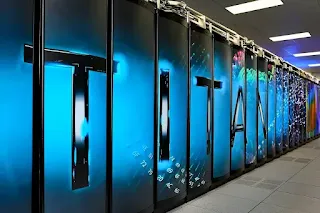
(1).jpg)

